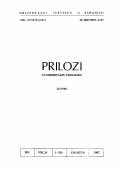The oldest vakuf charter in Yugoslavia
The oldest vakuf charter in Yugoslavia
Author(s): Hasan KalešiSubject(s): Language and Literature Studies
Published by: Orijentalni Institut u Sarajevu
Summary/Abstract: Until several years ago there existed in Bitolj (Manastir) a mosque called "Eski cami" (The Old Mosque). It was the oldest mosque in our regions and one of the oldest in the Balkans.. Its founder was Sungur bey, called Caus-bey, one of the commanders of sultan Murat II. It seems that Caus came from the region of Bitolj and that he was taken to Istanbul by means of devširme. Coming back from a campaign against Skenderbey in Albania, he stopped in Bitolj and he settled there. He built there the mentioned mosque and then a medresa and. a zavija, remnants of which can still be seen in Bitolj. Caus-bey also built a mesdžid in Jedren and another one in Vidin. For maintenance of these institutions he founded a foundation consisting of 25 shops, one han (inn), two pieces of land, 7 mills, 1 vineyard in Bitolj and another 11 shops and 17 rooms in Jedren and a mill in Vidin. Čaus-bey made his vakfija legal between 9th and 19th April 1435. This vakufnama written in Arab represents, in fact, the oldest Arabic or Turkish document discovered so far in Yugoslavia. The original of this document has not been discovered, but its copy is to be found in the sidžil of the seriat court in Manastir, No. 99, which is kept in Drzavni arhiv (State Archives) in Skopje. The author of this paper gives a critical view of the text of vakufnama. Its translation is accompanied by historical annotations and by explanations and fascimiles from the mentioned sidžil. If we compare this vakfija with other Macedonian ones we can see that it influenced the form of vakfijas in later period.
Journal: Prilozi za orijentalnu filologiju
- Issue Year: 1987
- Issue No: 36
- Page Range: 231-250
- Page Count: 20
- Language: English

